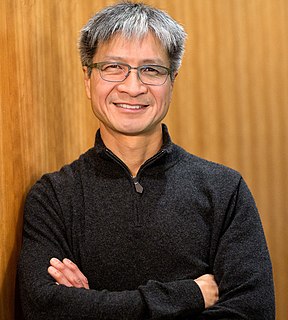Related Research Articles

Advanced Micro Devices, Inc. (AMD) is an American multinational semiconductor company based in Santa Clara, California, that develops computer processors and related technologies for business and consumer markets. While it initially manufactured its own processors, the company later outsourced its manufacturing, a practice known as going fabless, after GlobalFoundries was spun off in 2009. AMD's main products include microprocessors, motherboard chipsets, embedded processors and graphics processors for servers, workstations, personal computers and embedded system applications.

MIPS Technologies, Inc., formerly MIPS Computer Systems, Inc., was an American fabless semiconductor design company that is most widely known for developing the MIPS architecture and a series of RISC CPU chips based on it. MIPS provides processor architectures and cores for digital home, networking, embedded, Internet of things and mobile applications.

OpenGL is a cross-language, cross-platform application programming interface (API) for rendering 2D and 3D vector graphics. The API is typically used to interact with a graphics processing unit (GPU), to achieve hardware-accelerated rendering.

Silicon Graphics, Inc. was an American high-performance computing manufacturer, producing computer hardware and software. Founded in Mountain View, California in November 1981 by Jim Clark, its initial market was 3D graphics computer workstations, but its products, strategies and market positions developed significantly over time.

The Inquirer was a British technology tabloid website founded by Mike Magee after his departure from The Register in 2001. In 2006 the site was acquired by Dutch publisher Verenigde Nederlandse Uitgeverijen (VNU). Mike Magee later left The Inquirer in February 2008 to work on the IT Examiner.

ATI Technologies Inc. was a Canadian semiconductor technology corporation based in Markham, Ontario, that specialized in the development of graphics processing units and chipsets. Founded in 1985 as Array Technology Inc., the company listed publicly in 1993. Advanced Micro Devices (AMD) acquired ATI in 2006. As a major fabrication-less or fabless semiconductor company, ATI conducted research and development in-house and outsourced the manufacturing and assembly of its products. With the decline and eventual bankruptcy of 3dfx in 2000, ATI and its chief rival Nvidia emerged as the two dominant players in the graphics processors industry, eventually forcing other manufacturers into niche roles.

A graphics processing unit (GPU) is a specialized electronic circuit designed to rapidly manipulate and alter memory to accelerate the creation of images in a frame buffer intended for output to a display device. GPUs are used in embedded systems, mobile phones, personal computers, workstations, and game consoles.
Radeon is a brand of computer products, including graphics processing units, random-access memory, RAM disk software, and solid-state drives, produced by Radeon Technologies Group, a division of Advanced Micro Devices (AMD). The brand was launched in 2000 by ATI Technologies, which was acquired by AMD in 2006 for US$5.4 billion.
The AMD 700 chipset series is a set of chipsets designed by ATI for AMD Phenom processors to be sold under the AMD brand. Several members were launched in the end of 2007 and the first half of 2008, others launched throughout the rest of 2008.
The AMD 690 chipset series is an integrated graphics chipset family which was developed and manufactured by AMD subsidiary ATI for both AMD and Intel platforms focusing on both desktop and mobile computing markets. The corresponding chipset for the Intel platform has a marketing name of Radeon Xpress 1200 series.

Xilleon is a brand for a family of SoCs combining a low-power CPU with ASICs for accelerated video decompression and further functions for major worldwide broadcast networks targeting digital television.
AMD FireStream was AMD's brand name for their Radeon-based product line targeting stream processing and/or GPGPU in supercomputers. Originally developed by ATI Technologies around the Radeon X1900 XTX in 2006, the product line was previously branded as both ATI FireSTREAM and AMD Stream Processor. The AMD FireStream can also be used as a floating-point co-processor for offloading CPU calculations, which is part of the Torrenza initiative. The FireStream line has been discontinued since 2012, when GPGPU workloads were entirely folded into the AMD FirePro line.

Mark D. Papermaster is an American business executive currently serving as the chief technology officer (CTO) and executive vice president for Technology and Engineering at Advanced Micro Devices (AMD). On January 25, 2019 he was promoted to AMD's Executive Vice President. Papermaster previously worked at IBM from 1982 to 2008, where he was closely involved in the development of PowerPC technology and served two years as vice president of IBM's blade server division. Papermaster's decision to move from IBM to Apple Inc. in 2008 became central to a court case considering the validity and scope of an employee non-compete clause in the technology industry. He became senior vice president of devices hardware engineering at Apple in 2009, with oversight for devices such as the iPhone. In 2010 he left Apple and joined Cisco Systems as a VP of the company's silicon engineering development. Papermaster joined AMD on October 24, 2011, assuming oversight for all of AMD's technology teams and the creation of all of AMD's products, and AMD's corporate technical direction.
Silicon Graphics International Corp. was an American manufacturer of computer hardware and software, including high-performance computing solutions, x86-based servers for datacenter deployment, and visualization products. It was founded as Rackable Systems in 1999, but adopted the "SGI" name in 2009 after acquiring Silicon Graphics Inc. out of bankruptcy.
Bob Mansfield is an American hardware engineer working at Apple, Inc. He was formerly Senior Vice President of Technologies, before leaving that role to focus on unnamed future products. It has been claimed that he supervised the development of the Apple Watch or smart television products.
The graphics processing unit (GPU) codenamed Radeon R600 is the foundation of the Radeon HD 2000 series and the FireGL 2007 series video cards developed by ATI Technologies. The HD 2000 cards competed with nVidia's GeForce 8 series.

Lisa Su is a Taiwan-born American business executive and electrical engineer, who is the president and chief executive officer of Advanced Micro Devices (AMD). Early in her career, Su worked at Texas Instruments, IBM, and Freescale Semiconductor in engineering and management positions. She is known for her work developing silicon-on-insulator semiconductor manufacturing technologies and more efficient semiconductor chips during her time as vice president of IBM's Semiconductor Research and Development Center.

Rick Bergman was the president and CEO of Synaptics from 2011 to March 2019. He joined Synaptics in September 2011 from Advanced Micro Devices, Inc. (AMD), where he served as senior vice president and general manager of AMD's Product Group. He had been a longtime executive in the graphics chip business, serving in many positions at ATI Technologies before it was acquired in 2006 by AMD.

Victor Peng is a Taiwanese-American technology executive and CEO of Xilinx, an American technology company that supplies programmable logic devices.
Raja M. Koduri is a computer engineer and executive for computer graphics hardware. He is currently the chief architect and senior vice president of Intel's architecture, graphics and software (IAGS) division. Before Intel, he worked as the senior vice president and chief architect of the Radeon Technologies Group, the graphics division at Intel's competitor AMD. He was born in Kovvur, West Godavari District, Andhra Pradesh in India.
References
- 1 2 "David Orton Appointed Chief Executive Officer of Aptina". Press release. Aptina. July 15, 2009. Archived from the original on May 18, 2013. Retrieved August 5, 2013.
- ↑ John Markoff (May 7, 1996). "Resolving Conflicts in Supercomputer Deal". The New York Times. Retrieved August 5, 2013.
- ↑ "ATI Technologies Inc. completes acquisition of ArtX, Inc". Press release. April 5, 2000. Retrieved August 5, 2013.
- ↑ "ati Interview with Dave Orton". Hardware Heaven. Archived from the original on August 5, 2013. Retrieved August 5, 2013.
- ↑ Robert M. Frank (June 28, 2001). "Hardware: Chip Maker Trims Loss". The New York Times. Retrieved August 5, 2013.
- ↑ "Dave Orton named as ATI's next CEO: KY Ho to remain as Chairman, and continue to drive ATI's strategic business relationships". Press release. ATI Technologies. March 31, 2004. Retrieved August 5, 2013.
- ↑ "AMD Announces the Resignation of Dave Orton, former CEO of ATI". Press release. Business Wire. July 10, 2007. Retrieved August 5, 2013.
- ↑ Martin Veitch (December 21, 2007). "The INQUIRER Top 10 CEOs that went in 2007". The Inquirer. Archived from the original on April 7, 2014. Retrieved August 5, 2013.CS1 maint: unfit URL (link)
- 1 2 "Board of Directors". Corporate web site. SuVolta. Retrieved August 5, 2013.
- ↑ "Aptina Appoints Phil Carmack As Chief Executive Officer". Press release. Aptina. May 29, 2013. Archived from the original on June 23, 2013. Retrieved August 5, 2013.
- ↑ Lawrence Latif (June 6, 2011). "Planar transistors are given a new lease on life by ex-ATI boss". The Inquirer. Archived from the original on June 9, 2011. Retrieved August 5, 2013.CS1 maint: unfit URL (link)